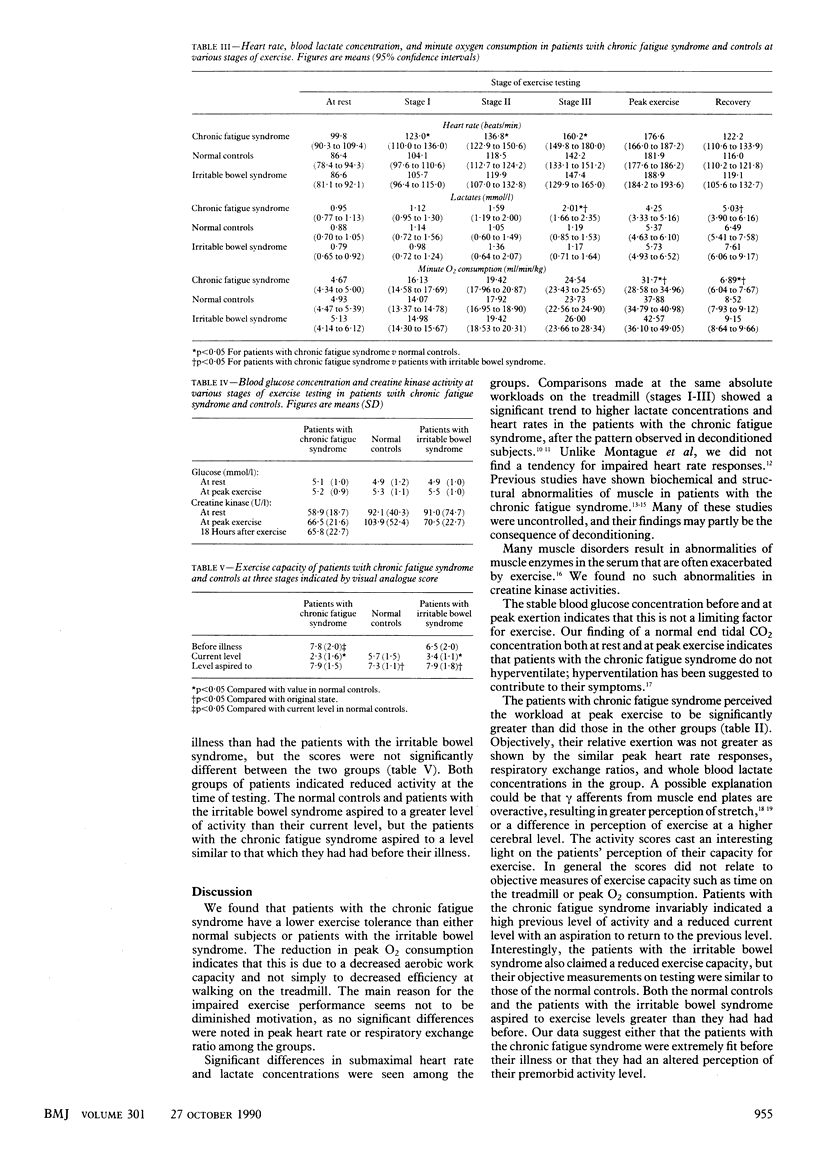Abstract
OBJECTIVE--To determine the aerobic work capacity of patients with the chronic fatigue syndrome and compare it with that of two control groups, and to assess the patients' perception of their level of activity before and during illness. DESIGN--A symptom limited exercise treadmill test with on line gas analysis and blood sampling was used. Subjects were assessed by one investigator, who was blind to the group which they were in. SETTING--Department of medicine, Royal Victoria Hospital, Belfast. SUBJECTS--13 Patients (10 women, three men) who fulfilled the diagnostic criteria for chronic fatigue syndrome. Two control groups of similar age, sex, and body weight: 13 normal subjects (10 women, three men) and seven patients (five women, two men) with the irritable bowel syndrome. MAIN OUTCOME MEASURES--Aerobic work capacity as assessed by several variables such as length of time on treadmill, heart rate, and biochemical measurements; Borg score; and visual analogue scores of perceived level of physical activity. RESULTS--The patients with the chronic fatigue syndrome had a reduced exercise capacity compared with that of the other subjects, spending a significantly shorter time on the treadmill. They had a significantly higher heart rate at submaximal levels of exertion and at stage III exertion had significantly higher blood lactate concentrations. Using a Borg score, they showed a significantly altered perception of their degree of physical exertion with a mean score of 8.2 compared with 6.6 and 5.3 for the normal subjects and patients with the irritable bowel syndrome respectively. Using a visual analogue scale they indicated that they had a greater capacity for activity before illness than had the patients with the irritable bowel syndrome, but the scores were not significantly different between the two groups. Both groups of patients indicated reduced activity at the time of testing. Normal controls and patients with the irritable bowel syndrome aspired to a greater level of activity than their current level, but the patients with the chronic fatigue syndrome aspired to a level similar to that which they had had before their illness. CONCLUSIONS--Patients with the chronic fatigue syndrome have reduced aerobic work capacity compared with normal subjects and patients with the irritable bowel syndrome. They also have an altered perception of their degree of exertion and their premorbid level of physical activity.
Full text
PDF



Selected References
These references are in PubMed. This may not be the complete list of references from this article.
- Archard L. C., Bowles N. E., Behan P. O., Bell E. J., Doyle D. Postviral fatigue syndrome: persistence of enterovirus RNA in muscle and elevated creatine kinase. J R Soc Med. 1988 Jun;81(6):326–329. doi: 10.1177/014107688808100608. [DOI] [PMC free article] [PubMed] [Google Scholar]
- Arnold D. L., Bore P. J., Radda G. K., Styles P., Taylor D. J. Excessive intracellular acidosis of skeletal muscle on exercise in a patient with a post-viral exhaustion/fatigue syndrome. A 31P nuclear magnetic resonance study. Lancet. 1984 Jun 23;1(8391):1367–1369. doi: 10.1016/s0140-6736(84)91871-3. [DOI] [PubMed] [Google Scholar]
- Behan P. O., Behan W. M., Bell E. J. The postviral fatigue syndrome--an analysis of the findings in 50 cases. J Infect. 1985 May;10(3):211–222. doi: 10.1016/s0163-4453(85)92488-0. [DOI] [PubMed] [Google Scholar]
- Bell E. J., McCartney R. A., Riding M. H. Coxsackie B viruses and myalgic encephalomyelitis. J R Soc Med. 1988 Jun;81(6):329–331. doi: 10.1177/014107688808100609. [DOI] [PMC free article] [PubMed] [Google Scholar]
- Borg G. A. Psychophysical bases of perceived exertion. Med Sci Sports Exerc. 1982;14(5):377–381. [PubMed] [Google Scholar]
- Bruce R. A. Exercise testing of patients with coronary heart disease. Principles and normal standards for evaluation. Ann Clin Res. 1971 Dec;3(6):323–332. [PubMed] [Google Scholar]
- Byrne E., Trounce I. Chronic fatigue and myalgia syndrome: mitochondrial and glycolytic studies in skeletal muscle. J Neurol Neurosurg Psychiatry. 1987 Jun;50(6):743–746. doi: 10.1136/jnnp.50.6.743. [DOI] [PMC free article] [PubMed] [Google Scholar]
- Clode M., Campbell E. J. The relationship between gas exchange and changes in blood lactate concentrations during exercise. Clin Sci. 1969 Oct;37(2):263–272. [PubMed] [Google Scholar]
- Elborn J. S., Stanford C. F., Nicholls D. P. Reproducibility of cardiopulmonary parameters during exercise in patients with chronic cardiac failure. The need for a preliminary test. Eur Heart J. 1990 Jan;11(1):75–81. doi: 10.1093/oxfordjournals.eurheartj.a059596. [DOI] [PubMed] [Google Scholar]
- Holmes G. P., Kaplan J. E., Gantz N. M., Komaroff A. L., Schonberger L. B., Straus S. E., Jones J. F., Dubois R. E., Cunningham-Rundles C., Pahwa S. Chronic fatigue syndrome: a working case definition. Ann Intern Med. 1988 Mar;108(3):387–389. doi: 10.7326/0003-4819-108-3-387. [DOI] [PubMed] [Google Scholar]
- Manning A. P., Thompson W. G., Heaton K. W., Morris A. F. Towards positive diagnosis of the irritable bowel. Br Med J. 1978 Sep 2;2(6138):653–654. doi: 10.1136/bmj.2.6138.653. [DOI] [PMC free article] [PubMed] [Google Scholar]
- Montague T. J., Marrie T. J., Klassen G. A., Bewick D. J., Horacek B. M. Cardiac function at rest and with exercise in the chronic fatigue syndrome. Chest. 1989 Apr;95(4):779–784. doi: 10.1378/chest.95.4.779. [DOI] [PubMed] [Google Scholar]
- Stokes M. J., Cooper R. G., Edwards R. H. Normal muscle strength and fatigability in patients with effort syndromes. BMJ. 1988 Oct 22;297(6655):1014–1017. doi: 10.1136/bmj.297.6655.1014. [DOI] [PMC free article] [PubMed] [Google Scholar]
- Woods J. J., Furbush F., Bigland-Ritchie B. Evidence for a fatigue-induced reflex inhibition of motoneuron firing rates. J Neurophysiol. 1987 Jul;58(1):125–137. doi: 10.1152/jn.1987.58.1.125. [DOI] [PubMed] [Google Scholar]


